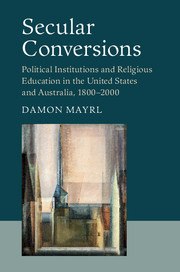 Secular Conversions
Secular Conversions Book contents
- Frontmatter
- Contents
- List of Figures and Tables
- Acknowledgments
- List of Acronyms
- Introduction
- 1 Politics, Institutions, and Secularization
- Part I Forging the nineteenth-century settlement
- 2 State-Building and Secularization in Comparative Perspective
- Part II The nineteenth-century settlement in transition
- Part III Forging the twentieth-century settlement
- Part IV Implications
- Epilogue: Toward a Twenty-First-Century Settlement?
- Index
2 - State-Building and Secularization in Comparative Perspective
from Part I - Forging the nineteenth-century settlement
Published online by Cambridge University Press: 05 August 2016
- Frontmatter
- Contents
- List of Figures and Tables
- Acknowledgments
- List of Acronyms
- Introduction
- 1 Politics, Institutions, and Secularization
- Part I Forging the nineteenth-century settlement
- 2 State-Building and Secularization in Comparative Perspective
- Part II The nineteenth-century settlement in transition
- Part III Forging the twentieth-century settlement
- Part IV Implications
- Epilogue: Toward a Twenty-First-Century Settlement?
- Index
Summary
INTRODUCTION
In the nineteenth century, jurisdiction over education shifted from the churches to the state in both Australia and the United States. In the United States, the diverse array of private, denominational, and town schools that prevailed in the early national era were slowly gathered together into a coherent system of “common schools.” In Australia, the mostly denominational system that grew out of the convict garrisons was edged out by a new system of government schools after the colonies were granted responsible government in the 1850s. By 1880, the two nations had settled on remarkably similar secular settlements. The state dominated schooling in both countries, providing free education to all children irrespective of class or religious background. Each nation had erected strong legal barriers against funding for denominational schools (“public aid” or “state aid”), but were remarkably open to religious instruction in the public schools – especially instruction in a “nondenominational” Christianity heavily colored by Protestant assumptions. Yet although their settlements were similar, each nation's system of educational administration differed dramatically. In the United States, common schools were governed through a decentralized network of thousands of local school boards, while in Australia, government schools were run out of highly centralized state ministries of education.
Why did Australia and the United States arrive at nineteenth-century settlements that were so similar in their approach to religious education, yet so different in their administrative structure? I argue that the nearly complete shift in control from church to state in each country was driven primarily by the state-building process. In both countries, an organized campaign, led by actors determined to make education universal and subject to state control, succeeded in relocating the primary responsibility for education from the churches to the state. Yet state-building interacted differently with religious conflict in the two nations, in ways that shaped the administrative structures that ultimately developed. In the United States, the state-building process was driven largely from the bottom up with the avid participation of evangelical Protestant clergy. As a result, it was able to coopt the existing educational infrastructure, leading to an administratively decentralized school system that harmoniously fused state education with a strongly Protestant curriculum.
- Type
- Chapter
- Information
- Secular ConversionsPolitical Institutions and Religious Education in the United States and Australia, 1800–2000, pp. 41 - 78Publisher: Cambridge University PressPrint publication year: 2016
